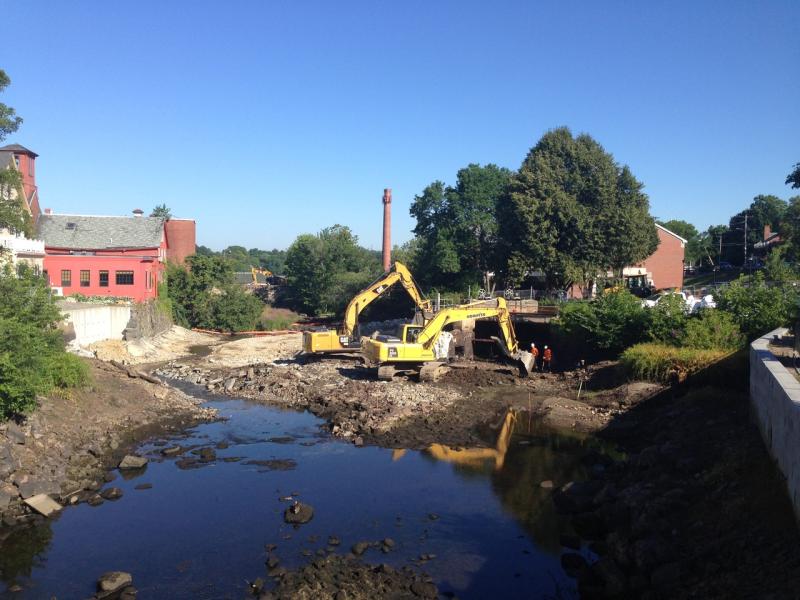These projects will restore roughly 1,400 acres of habitat and open 70 stream miles for fish passage. In addition to the 10 new projects funded this year, eleven projects started in 2016 will receive $5 million to continue planned restoration activities. This will include transitioning some projects from design phase to construction.
The selected projects aim to rebuild fish stocks, help recover threatened and endangered species, or benefit other coastal and marine species (such as forage fish).
Six of the projects will benefit species listed under the Endangered Species Act, including two projects that will support the recovery of Species in the Spotlight. One project is located in a NOAA Habitat Focus Area.
Restoration efforts include:
Pacific Northwest and Alaska
Fish Passage Restoration in Alaska ($300,000): In partnership with the Tyonek Tribal Conservation District, this project will replace two undersized culverts and re-route one road. This will restore access to nine upstream miles and 130 lake acres to multiple salmon species. The project will provide benefits to both salmon and Cook Inlet Beluga Whales that rely on salmon as a food source.
Coast Coho Recovery Plan Implementation ($836,645): In partnership with Wild Salmon Center, this project will implement several projects to increase off-channel rearing habitat and improve the quality of in-stream habitat for Endangered Species Act-listed salmon. Efforts will include adding large woody debris and reducing water temperatures in coastal Oregon rivers. The selected projects will be implemented across three priority watersheds.
Pacific Southwest- California and Hawaii
Kawaihae Watershed Restoration ($646,886): In partnership with The Kohala Center, this project will reduce land-based sediment runoff in the Kawaihae watershed within the West Hawaii Habitat Focus Area. The project will erect 12 miles of fencing to protect 8,500 acres, remove more than 1,000 feral goats from the landscape, and plant native trees and shrubs in a 10-acre riparian corridor. This will restore one of the most degraded watersheds in the region. It will also improve the health and function of the nearshore coral reef ecosystem.
Lawrence Creek Reconnection of Critical Off-Channel Salmon Habitat ($154,470): In partnership with Trout Unlimited, this project will design and construct an off-channel floodplain habitat restoration project in Lawrence Creek. Lawrence Creek is a high priority stream for the recovery of Endangered Species Act-listed salmon and steelhead in California. The project will restore approximately five acres and approximately 1,000 feet of off-channel habitat.
Ocean Ranch Restoration Project ($125,000): In partnership with Ducks Unlimited, this project will restore estuarine and coastal dune habitat in more than 800 acres of the Eel River estuary in California. This work will support the recovery of Endangered Species Act-listed steelhead, coho, and Chinook salmon. This will reestablish a healthy ecosystem, increase resilience to storm events and sea level rise, and provide habitat for juvenile migratory fish to grow before heading out to sea. The project will also enhance populations for 14 managed species.
Lower Prairie Creek Restoration Project ($289,500): In partnership with Save the Redwoods League, this project will restore rearing, spawning, and over-winter habitat for three species of Endangered Species Act-listed salmon. Efforts will include improving habitat complexity, restoring floodplain access, and increasing food and growth potential for juvenile fish. The Prairie Creek watershed contains some of the best potential habitat to contribute to the recovery of steelhead, coho, and Chinook salmon within the larger watershed system.
Pescadero Creek Streamflow Improvement Project ($421,764): In partnership with San Mateo County Resource Conservation District, this project will implement irrigation improvements and create an off-stream reservoir in San Mateo County, California. This will directly benefit Endangered Species Act-listed salmon by reducing diversion rates in Pescadero Creek during critical streamflow periods. This will allow for enough water flow for salmon to migrate upstream.
Northeast
Holmes Dam Removal ($1,500,000): In partnership with the Town of Plymouth, Massachusetts, this project will remove a 16-foot high, 275-foot-long high-hazard dam and a bridge in poor condition. This will open access for river herring to spawning habitat, leading to a predicted increase in the fish run of 200,000 additional fish. The removal will also protect surrounding infrastructure and will reduce flood vulnerability during extreme weather events.
Monatiquot River Restoration Project ($100,000): In partnership with the Massachusetts Department of Fish and Game, this project will complete engineering and design for the removal of the Armstrong and Ames Pond Dams on the Monatiquot River. Removal of these dams will restore unimpeded access to 36 miles of river corridor for river herring and American eel. Dam removal will also eliminate any risk of dam failure and potential damage to surrounding infrastructure.
Restoring Passage for Alewife and Atlantic Salmon in the Upper Narraguagus River Watershed ($154,000): In partnership with Project SHARE, this project will replace six culverts in the upper Narraguagus River watershed in coastal Maine. Restoring access to cold-water tributaries is a top priority for recovery of Endangered Species Act-listed Atlantic salmon. This project will restore fish passage to approximately 18 stream miles and improve access to nearly 300 acres of important spawning and rearing habitat for Atlantic salmon, alewife and American eel.



